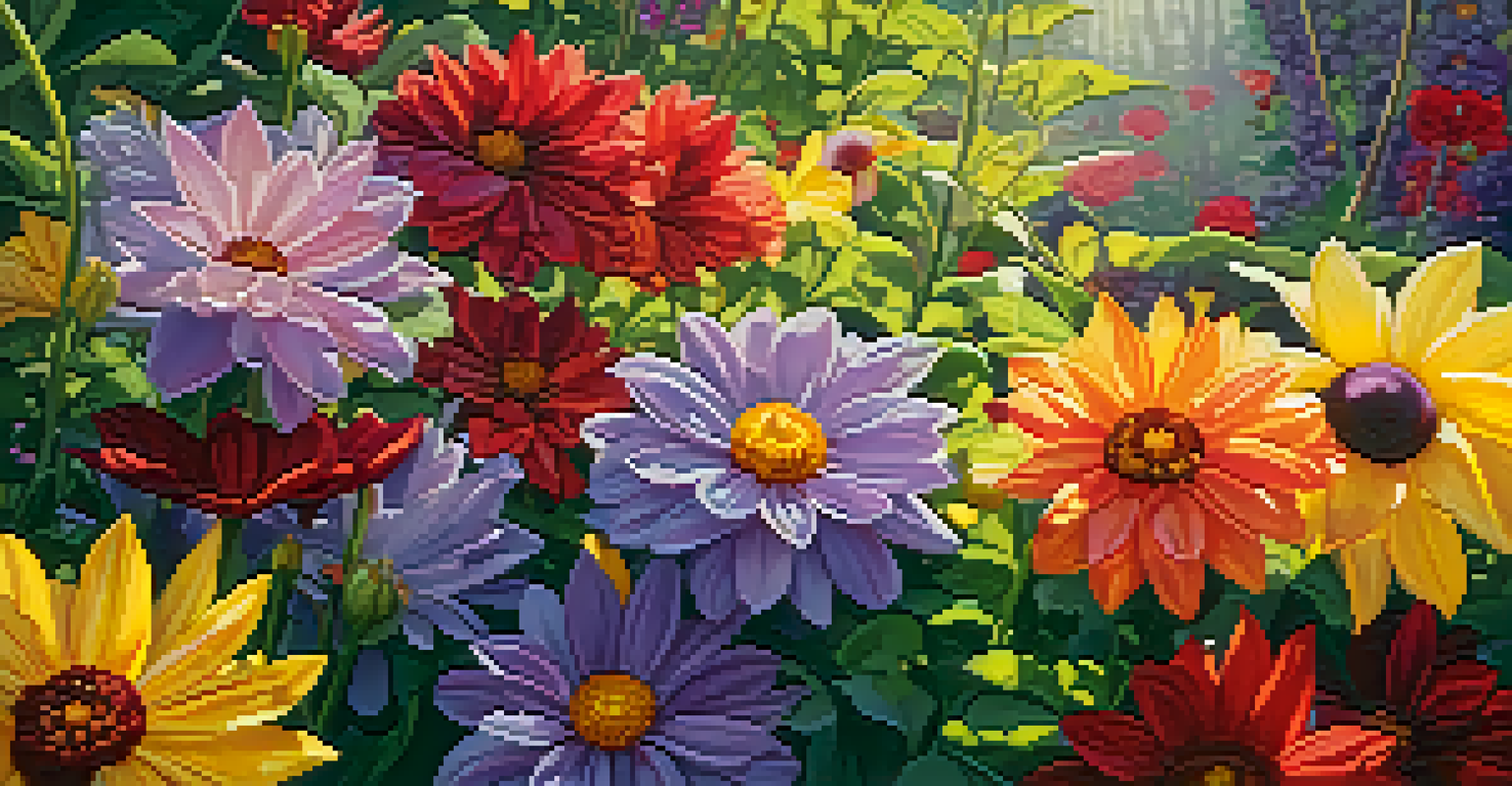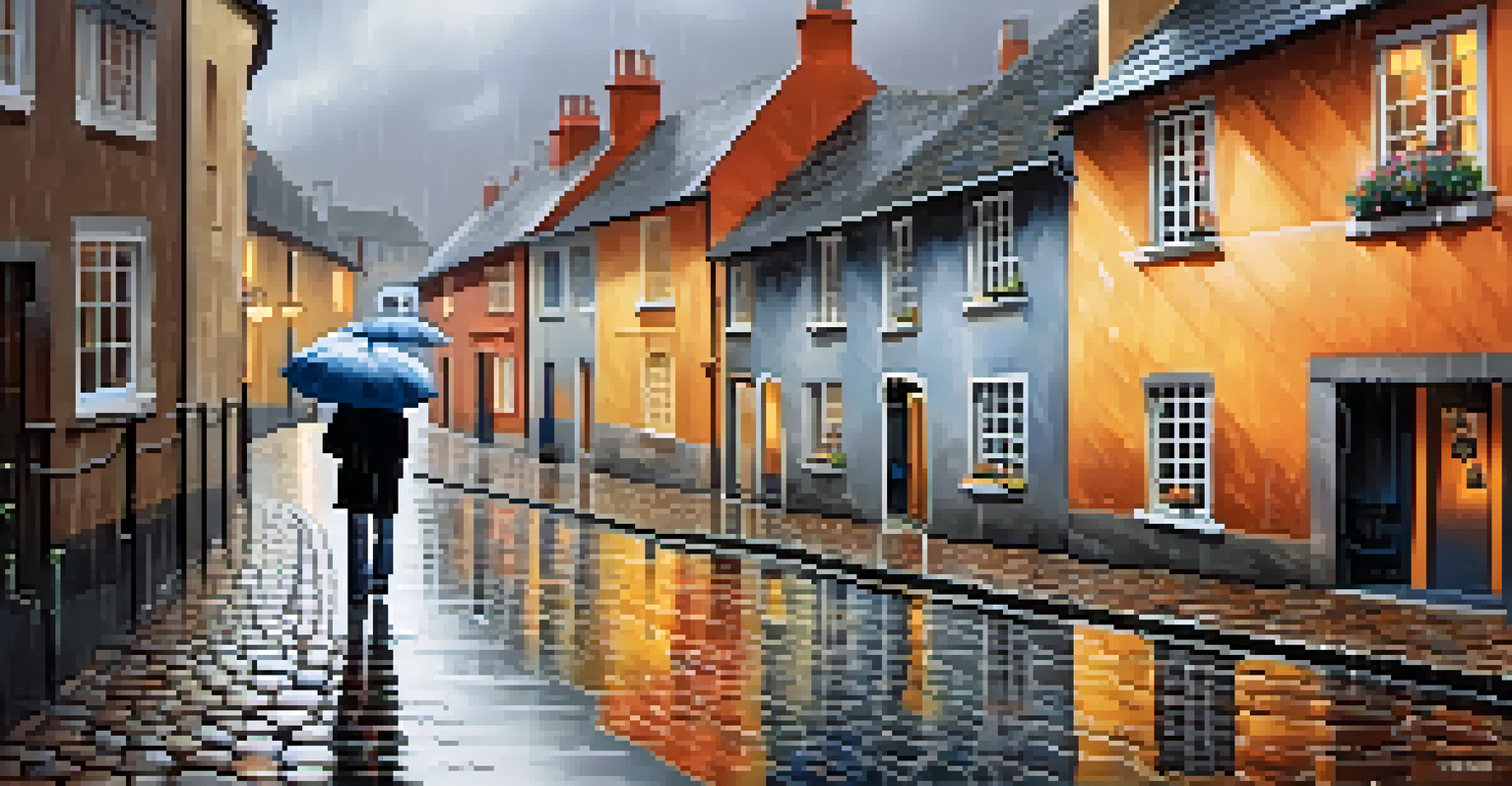The Colors of Emotion: Painting's Impact on Romantic Literature

Understanding the Intersection of Color and Emotion
Color plays a vital role in shaping our emotions, often acting as a visual language that communicates feelings beyond words. In literature, particularly romantic literature, authors frequently evoke specific colors to enhance the emotional depth of their narratives. For instance, the use of red might symbolize passion and love, while blue can convey melancholy or longing, creating a rich tapestry of emotional experiences for the reader.
Color is the keyboard, the eyes are the harmonies, the soul is the piano with many strings.
Similarly, in painting, artists utilize color to elicit emotional responses from viewers. A vivid sunset painted in warm hues can evoke feelings of hope and tranquility, while a stormy seascape in dark shades might instill a sense of unease or turmoil. This interplay between color and emotion not only enriches our understanding of both art forms but also reveals the underlying feelings that connect them.
By examining how colors are used to convey emotions in romantic literature and painting, we can gain a deeper appreciation for how these two art forms reflect the complexities of human experience. This exploration invites us to consider our personal emotional responses to color and how they shape our interpretations of both literary and visual art.
The Role of Color in Romantic Literature
Romantic literature is inherently emotional, often exploring themes of love, loss, and nature. Authors like William Wordsworth and John Keats frequently employed color imagery to enhance their poetic expressions. For example, in Keats' 'Ode to a Nightingale,' he intertwines rich descriptions of nature with vibrant colors to evoke the beauty and transience of life, immersing readers in a world filled with sensory experiences.

Moreover, color symbolism in romantic literature serves as a powerful tool for character development. A character might be described as wearing green to symbolize jealousy or envy, while another draped in gold may represent wealth and aspiration. These color choices deepen our understanding of characters' inner lives and emotional struggles, making their journeys more relatable and compelling.
Color Shapes Emotional Experiences
Colors in both romantic literature and painting evoke deep emotional responses, enhancing our understanding of the human experience.
Through the lens of color, romantic literature invites readers to engage with the text on multiple levels. This not only enriches the reading experience but also encourages readers to reflect on their own emotional responses, fostering a connection between the text and their lived experiences.
The Influence of Color in Romantic Painting
In the realm of romantic painting, color is often employed to evoke powerful emotions and capture the essence of the human experience. Artists like J.M.W. Turner and Caspar David Friedrich used bold color palettes to portray dramatic landscapes that reflect inner turmoil or sublime beauty. Turner's use of fiery oranges and reds in his seascapes, for instance, conveys a sense of both awe and danger, drawing viewers into the emotional core of the scene.
Colors, like features, follow the changes of the emotions.
The emotional impact of color in romantic painting extends beyond mere representation; it also invites interpretation. Viewers are often compelled to explore the feelings that arise in response to different hues, allowing the artwork to resonate personally. For instance, a painting dominated by cool blues might evoke feelings of calmness, while vibrant yellows could inspire joy and warmth.
As we analyze the use of color in romantic painting, we uncover the emotional landscapes that artists sought to communicate. This exploration not only enhances our appreciation of the artwork but also highlights the universal human emotions that connect us all, transcending time and place.
Color Symbolism Across Different Cultures
Color symbolism varies significantly across cultures, influencing how emotions are expressed in both literature and art. For example, in Western cultures, red often symbolizes love and passion, while in some Eastern cultures, it represents happiness and good fortune. This cultural context can deeply affect how readers interpret literary works and how viewers engage with visual art.
In romantic literature, authors may draw upon these cultural associations to enrich their narratives. A story set in a culture where white symbolizes purity might use this color to highlight themes of innocence or virtue, while contrasting it with darker colors to signify conflict or moral ambiguity. Such layers of meaning add complexity to the emotional landscape of the narrative.
Cultural Context Influences Color Meaning
The symbolism of colors varies across cultures, affecting how emotions are expressed and interpreted in literature and art.
Similarly, artists must navigate these cultural nuances when choosing colors for their works. By understanding the emotional connotations associated with different colors in various cultures, they can create artwork that resonates more profoundly with diverse audiences, fostering a shared emotional experience.
The Psychological Effects of Color in Art and Literature
The psychological effects of color are well-documented, influencing our emotions and perceptions in profound ways. Research indicates that certain colors can evoke specific emotional responses; for instance, warm colors like red and orange can energize and stimulate, while cooler colors like blue and green can soothe and calm. This psychological aspect of color is crucial in both romantic literature and painting, guiding creators in their artistic choices.
In romantic literature, authors may deliberately choose colors that mirror a character's emotional state or the mood of a scene. For example, a character experiencing deep sorrow might be surrounded by descriptions of gray skies and muted colors, reinforcing the feeling of despair. This psychological interplay not only enhances the narrative but also allows readers to empathize with the characters on a deeper level.
Similarly, painters often consider the psychological impact of color when crafting their compositions. An artist's choice of color can influence how a viewer feels while engaging with the piece, shaping their overall interpretation. By understanding these psychological effects, both writers and artists can create more impactful works that resonate emotionally with their audiences.
The Interplay of Visual Art and Literature
The relationship between visual art and literature is intricate, with each medium often drawing inspiration from the other. Romantic literature frequently references paintings and artistic styles, using vivid descriptions that evoke the colors and emotions found in the visual arts. This interplay enriches the narrative, allowing readers to visualize scenes and feel the emotions conveyed through color.
Conversely, painters are inspired by literary themes and characters, often translating the emotional depth of written words into visual narratives. For instance, an artist might create a painting inspired by a romantic poem, capturing the essence of the emotions expressed in the text through color and composition. This symbiotic relationship allows both art forms to flourish, each enhancing the other.
Psychology of Color Affects Perception
The psychological effects of color influence how we perceive emotions in art and literature, guiding creators in their artistic choices.
Ultimately, the interplay between visual art and literature underscores the shared goal of both mediums: to evoke emotion and provoke thought. By examining how colors and emotions intertwine in both realms, we can appreciate the beauty of human expression and the diverse ways it manifests in our lives.
Conclusion: The Lasting Impact of Color in Romantic Expression
In conclusion, the colors of emotion play a pivotal role in both romantic literature and painting, shaping how we experience and interpret these art forms. Through the strategic use of color, authors and artists alike can evoke deep feelings, allowing us to connect with their work on a personal level. This connection enhances our understanding of the human experience, revealing the complexities of love, longing, and beauty.
As we explore the emotional landscapes created by color, we are reminded of the power of art to transcend language and culture. Whether through the vivid imagery of a poem or the striking hues of a painting, color serves as a universal language that speaks to our shared humanity. This exploration encourages us to reflect on our own emotional responses and the colors that resonate with us personally.

Ultimately, the impact of color in romantic expression endures, inviting us to engage with art and literature in new and meaningful ways. As we continue to explore this vibrant interplay, we can appreciate the profound ways in which color shapes our emotional experiences and enriches our understanding of the world around us.